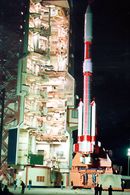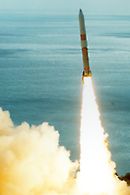Reorganization of ISAS and New Launch Vehicles
In 1981, by reorganizing the former ISAS, the Institute
of Space and Astronautical Science (new ISAS) was newly established as
one of the National Inter-University Research Institutes directly belonging
to the Ministry of Education, Science, Sports and Culture. Taking over the space
project of its predecessor, the new ISAS began more ambitious activities
toward even higher levels of space science.
 |
M-3SII
Targeting Halley's comet which would reappear in 1985 after 76 years,
ISAS began research and development of the fifth and latest generation
MU vehicle, M-3SII, in April 1981. It utilized the first stage motor
of its predecessor M-3S, while the 2nd and the 3rd stage motors
and strap-on boosters were newly developed to enhance the payload
capability. M-3SII-1 and -2, with an optional fourth stage, carried
the first Japanese interplanetary probes, SAKIGAKE and SUISEI in
January and August 1985 toward Halley's comet. In February 1987,
February 1989, January 1990, August 1992 and February 1993, respectively,
ISAS sent five satellites into earth orbit, GINGA, AKEBONO, HITEN,
YOHKOH and ASCA.
One more satellite, EXPRESS, was
launched for the last flight of M-3SII launch vehicle in February
1994, but resulted in a failure. |
 |
M-V
Space science using solid propellant rockets in Japan, which uttered
its first cries in a small laboratory in 1955, has attained fruitful
results including world-leading achievements in X-ray astronomy
and space plasma physics, and went beyond the earth's gravitation
into heliocentric space in 1985 toward the observation of Halley's
comet. It was followed by the first Japan's Mars explorer, NOZOMI,
in 1998, and Japan's space science can be said to have entered into
a new era for solar system exploration with the advent of the M-V
launch vehicle. M-V sent HALCA, NOZOMI, HAYABUSA, SUZAKU, AKARI and HINODE into orbit around the earth and interplanetary space. The M-V's last flight was the launch of HINODE on September 23, 2006. |
|


|
|